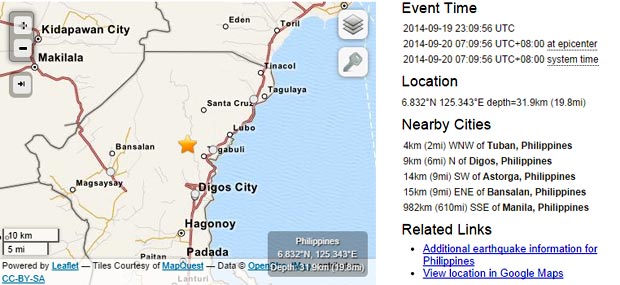Central Mindanao quakes topple, damage over 50 houses
KIDAPAWAN CITY, Philippines—A swarm of earthquakes struck Central Mindanao on Saturday, with the strongest one at noon knocking down at least 15 houses and damaging more than three dozen other structures in the town of Makilala in North Cotabato, officials said.
There were no other reports of major damage or casualties outside Makilala, where at least one person was reported hurt during the quake, which was the eighth to hit the region on Saturday and had a magnitude of 5, according to the local office of Philippine Institute of Volcanology and Seismology.
Phivolcs said it recorded a total of 38 aftershocks after the magnitude-5 quake, which struck at 12:26 p.m.
Makilala lies near the epicenter of Saturday’s first earthquake, which occurred at 5:59 a.m., with its epicenter traced six kilometers southeast of the town. It had a magnitude of 4.4 and came a little over six hours before the strongest of Saturday’s tremors.
The municipal social welfare office in Makilala said at least 15 houses were destroyed there while about three dozen other structures, including a chapel, sustained varying degrees of damage.
Article continues after this advertisement“A boy was hurt when falling debris and hallow blocks from their house collapsed but he was okay with just minor bruises,” said Cynthia Ortega, an officer of the North Cotabato Provincial Risk Reduction and Management Council.
Article continues after this advertisementOrtega said she and North Cotabato Governor Emmylou Mendoza were in Barangay Luayon for the village’s 62nd foundation anniversary along with other officials when the strongest jolt took place.
“I was there when the jolting happened. People had to stop for a while during the program when tremors were felt, and then they continued with the activities after the shaking stopped,” Mendoza told reporters.
Hermes Daquipa, Phivolcs chief volcanologist in the region, said they had received reports that some houses in Kidapawan City had also sustained damage.
A private school in Kidapawan City called off its annual intramural meet due to the tremors.
Mary Ann Ordinario-Floresta, the school’s owner, said she immediately sent the students home.
“We don’t want to sacrifice the safety of our school children. We will resume our intramurals on Monday,” she said.
The magnitude-5 quake was preceded by at least seven other quakes with separate epicenters.
Phivolcs said the epicenter of Saturday’s strongest quake was 14 kilometers south of Kidapawan City.
The first tremor, which had a magnitude of 4.4 took, occurred at 5:59 a.m. some six kilometers southeast of Makilala, North Cotabato.
The quake was tectonic in origin and had a depth of one kilometer, Phivolcs said.
At 6:05 a.m. a second jolt with a magnitude 3.6 occurred some four kilometers southeast of Columbio in Sultan Kudarat. It was followed by a 2.6 magnitude jolt that took place eight kilometers northeast of the same town.
Around 7 a.m., a much stronger quake with a magnitude 4.7 took place 14 kilometers southeast of Kidapawan City. (Phivolcs earlier said it was 13 kilometers northeast of Columbio).
It was felt at Intensity 4 in Kidapawan City and Makilala; Intensity 3 in Mlang and Tulunan – both in North Cotabato; and Intensity 2 in Matalam and Antipas, still in North Cotabato, according to Milo Tabigue of the Philvolcs office in Kidapawan.
At 7:18 a.m., another jolt at magnitude 3 originated 9 kilometers northeast of Columbio, followed by a 3.3 magnitude quake at 10:17, also in Columbio.
The seventh quake – measuring magnitude 2.8 occurred 10:54 a.m. and its epicenter was traced 13 kilometers south of Kidapawan.
The 12:26 p.m. jolt was felt as far as Digos City in nearby Davao del Sur but no damage was reported.
Many areas of Central Mindanao, which is made up of the provinces of North and South Cotabato, Sultan Kudarat and Sarangani, lie between two local faults.
Earthquakes are a normal occurrence in the Philippines, which is within the so-called Pacific Ring of Fire.
Dozens of earthquakes are recorded in the country each week but many are too feeble to be felt by humans.
One of the worst earthquakes that took place in the country was the August 16, 1976 magnitude 7.9 tremor that triggered a tsunami in the Moro Gulf. It killed between 5,000 and 8,000 people in the Moro Gulf region that includes Cotabato City and Pagadian City.
